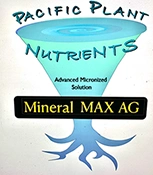Soil & Roots Exchange in the Rhizosphere
Article by Paul Gaylon
Blue Green Algae as a Participant in the Food Soil Web
Algae have been a pioneer species for 3.5 billion years. The exchange between algae, bacteria, and fungal matter, especially at lake edges, has been occurring for approximately 300 million years. Klamath Lake is naturally rich in phosphorus. Its vast nutrients which include amino acids, growth factors, vitamins, minerals, & enzymes are a biological wonder. AFA has continued to evolve and can seed and fortify the planet with tremendous nutrients. Mineral MAX AG Nutrient Biostimulant (AFA Klamath Lake algae) is applied 1 – 2 ounces per gallon to nourish and fortify plants. Plant root exudates provide sugars in the form of glycoprotein molecules and form several carbon sites that help stimulate mycorrhizal root growth. Oxygen is a by-product of the root exudates.
The sticky glycoprotein glomalin coats and seals the roots by way of the fungal hyphae and helps form larger aggregates in the soil thus improving the root–soil area (rhizosphere). The nutrients are brought forth from the soil through the roots along with minerals, vitamins, and enzymes to encourage a beneficial exchange between the soil and roots through both capillary action and electrical activity. Nutrients come back through root exudates to plants; a continuous feedback loop is formed. This intelligence exists in the shared exchanges for mutual benefit between plant and soil. Of course, better soil creates more biological activity sites. As hyphae die off, carbon on their coating nourishes the soil. The exchange between the root exudates & soil has multiple functions.
Uses
Mineral MAX AG Nutrient Biostimulant produces many positive plant outcomes. It creates rapid uptake in the plant and soil environments. The high nutrient content (growth factors, etc.) and plant sugars interact with soil bacteria to accelerate root growth. Numerous testimonials have confirmed this. A test plot should provide side-by-side results that speak for themselves. High NPK numbers do not work with the Food Soil web. By using algae, nutrients support plants and continue on to the soil via exudates. Algae acts like a microbe food.
Mineral MAX AG can be used by itself to nourish plants and encourage root, leaf, flower & fruit growth. It can also be combined with other nutrients such as mycorrhizal inoculants, molasses, sea plants, alfalfa meal, humic acid, fish waste for synergy. All of these provide good general support for plants and soil. Mineral MAX AG is a fine stand-alone plant food as well.
Each nutrient (amino acids, vitamins, etc.) component has complexity. There are over 40 main minerals and with 30+ trace minerals with high assimilation. There are many types of enzymes, lipids (lipoproteins), carbohydrates (glycoproteins), amino acids, chlorophyll, carotenoids, & phycocyanins (blue pigments). See the Analysis Chart. AFA tends to be very corrective.
Composition of AFA
Aminos: Macromolecules with carbohydrates, glycoproteins, fats lipoprotein, nucleic acid (RNA, DNA) nucleopeptides. Contain all fat- and water-soluble vitamins, many types of minerals, sulfated fatty polysaccharides, and sulfoglycolipids. Many are a blend of categories.
Phosphoglycolipids: Macromolecules on cell membranes and walls of AFA. They contain phosphate and carbohydrate as integral structural components.
The Klamath Lake Blue Green wild-harvested algae used in Mineral MAX AG is processed in a certified organic facility.
